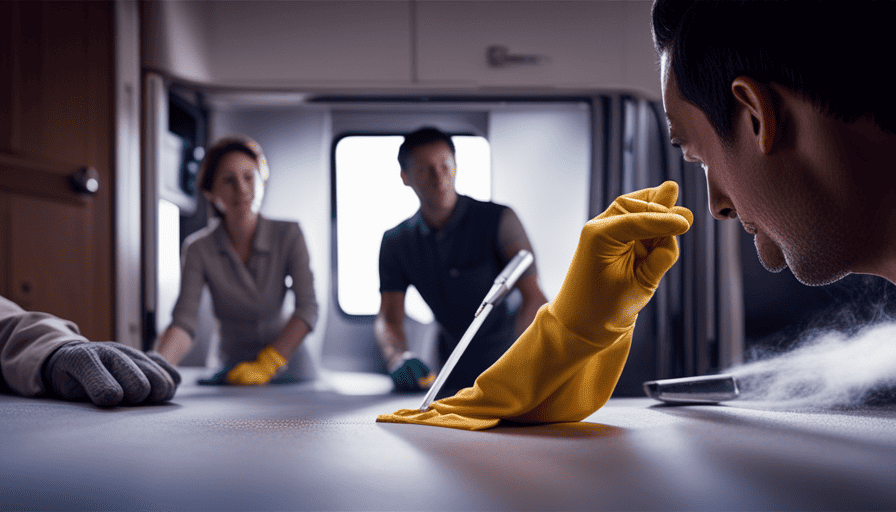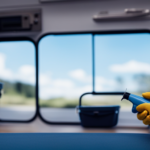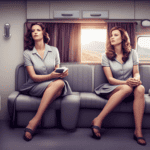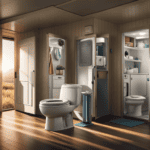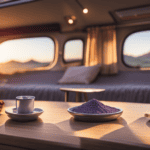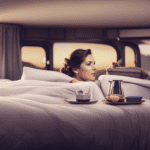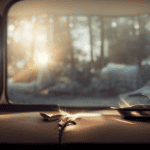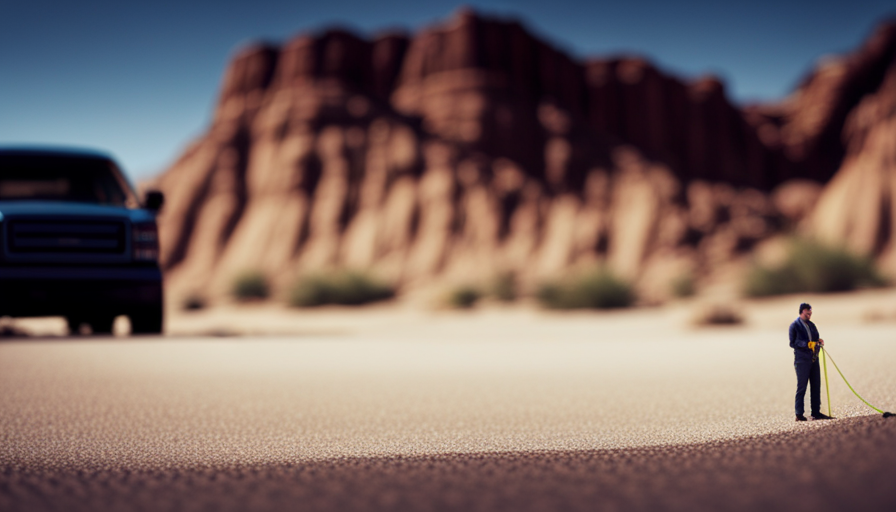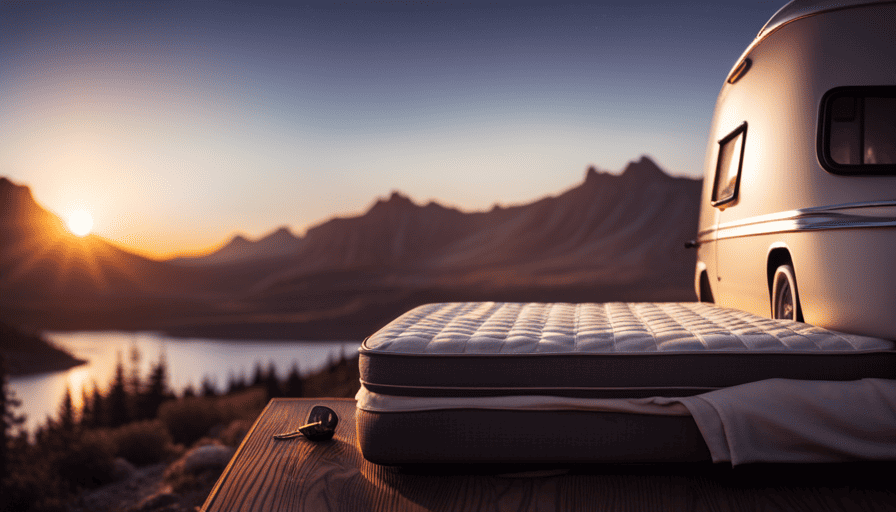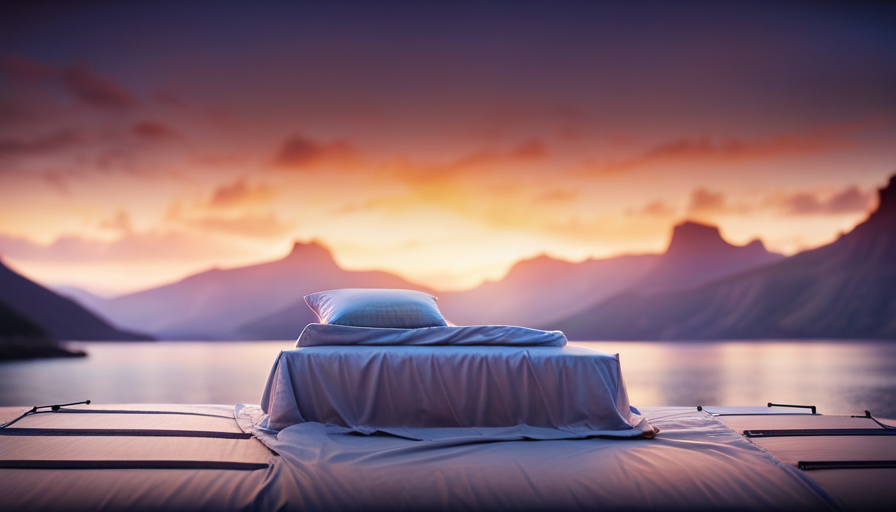Have you ever walked into your RV and been greeted with a foul odor reminiscent of rotting sewage? Dealing with a sewer smell in your RV can be unpleasant and off-putting. But fear not, as I am here to guide you through the steps to get rid of that unpleasant smell once and for all.
Like a seasoned traveler who has encountered this issue countless times, I will share with you my tried-and-true methods for getting rid of that pesky sewer smell. From identifying the source of the smell to practicing good RV hygiene, I will provide you with a step-by-step guide that will leave your camper smelling fresh and clean.
So, grab your cleaning supplies and let’s embark on this journey to eliminate the sewer smell from your beloved camper.
Key Takeaways
- Clean and sanitize holding tanks using specialized cleaning products
- Ensure proper ventilation in the camper’s bathroom to prevent moisture buildup and eliminate odors
- Fix plumbing leaks in the camper to prevent further damage and sewer smells
- Regularly clean and empty black and gray water tanks to prevent odor buildup
Identify the Source of the Smell
Now, let’s dive into identifying the source of that pesky sewer smell in your camper and get ready to say goodbye to it in no time!
One of the most common causes of a sewer smell in campers is a problem with the holding tanks. These tanks are responsible for storing both the gray water from your sinks and shower, as well as the black water from your toilet. If these tanks aren’t properly cleaned and maintained, they can start to emit a foul odor.
To troubleshoot the issue, start by checking the tank vents. These vents allow for the release of gases that can build up in the tanks. Make sure they’re clear of any obstructions, such as debris or insects, that could be preventing the gases from escaping.
Next, inspect the tank seals and connections for any leaks or cracks. Even a small leak can cause a strong odor to permeate your camper. Additionally, check the toilet seal to ensure it’s properly sealed when not in use. A faulty seal can allow sewer gases to enter your living space.
Finally, inspect the drain traps under your sinks and shower. These traps are designed to hold water and prevent odors from coming back up into your camper. If they’re dry, simply pour some water down the drain to replenish the trap.
With these troubleshooting tips, you should be able to identify and address the source of the sewer smell in your camper. Now, let’s move on to the next step of cleaning and sanitizing the holding tanks.
Clean and Sanitize the Holding Tanks
To effectively eliminate the unpleasant odor in your camper, start by thoroughly cleaning and sanitizing the holding tanks. This step is crucial in getting rid of the sewer smell and ensuring a fresh and clean environment.
Here are some tips to help you with this process:
- Use specialized cleaning products designed for RV holding tanks. These products are formulated to break down waste and eliminate odors effectively.
- Scrub the tanks with a long-handled brush to remove any buildup or residue. Pay extra attention to the corners and crevices where bacteria and odor-causing substances can accumulate.
- Rinse the tanks thoroughly with clean water to remove any remaining debris or cleaning solution.
- Consider adding tank maintenance products, such as enzyme treatments or deodorizers, to prevent future odor issues and maintain a healthy tank system.
By following these steps and using the right cleaning products, you can ensure that your holding tanks are clean, sanitized, and odor-free.
Once the tanks are properly cleaned, it’s time to move on to the next step: flushing the plumbing system to eliminate any lingering smells and maintain optimal functionality.
Flush the Plumbing System
Next, you’ll want to flush your plumbing system to ensure a fresh and odor-free environment in your camper. Flushing the system is an essential step in preventing odors from lingering in your camper.
To start, turn off the water supply and open all the faucets in your camper, including the shower and toilet. This will allow any trapped water and odor-causing bacteria to flow out of the system.
Next, locate the drain valve on your camper’s plumbing system. Attach a hose to the valve and connect the other end to a sewer hookup or an appropriate disposal area. Open the drain valve and let the water run through the system for a few minutes. This will help flush out any remaining debris and bacteria that may be causing the sewer smell.
After flushing the system, close the drain valve and turn on the water supply. Let the water run through the faucets for a few more minutes to ensure all the lines are clear of any remaining odor-causing particles. Finally, close all the faucets and move on to the next step of ventilating the camper.
To ventilate the camper and further eliminate any lingering odors, open all the windows and roof vents. This will allow fresh air to circulate and replace any stale or sewer-like smells.
Ventilate the Camper
After flushing the system, it’s important to open all the windows and roof vents to let fresh air circulate and eliminate any lingering odors in your camper. Increasing airflow is key to getting rid of that unpleasant sewer smell. By opening the windows and vents, you allow the stale air to escape and fresh air to enter, effectively ventilating the camper. This simple step can make a big difference in eliminating the odor.
To emphasize the importance of ventilating your camper, take a look at the table below:
| Benefits of Ventilating Your Camper | ||||
|---|---|---|---|---|
| 1. Removes unpleasant odors | 2. Reduces humidity buildup | 3. Improves air quality | 4. Prevents mold and mildew growth | 5. Enhances overall comfort |
By opening the windows and roof vents, you not only get rid of the sewer smell, but you also create a more pleasant and healthier environment inside your camper. Once you have ventilated the space, you can move on to the next step: using odor absorbers. These will help further eliminate any remaining odors and keep your camper smelling fresh.
Use Odor Absorbers
Using odor absorbers is a great way to freshen up the air inside your camper and create a more pleasant environment for your camping experience. When it comes to getting rid of sewer smell in your camper, odor eliminators and air fresheners can be extremely effective.
These products work by neutralizing and eliminating unpleasant odors, leaving behind a clean and fresh scent. One camper shared their experience of using odor absorbers in their camper. They noticed a significant improvement in the air quality, with the sewer smell completely eliminated. This allowed them to enjoy their camping trip without any unpleasant odors lingering around.
The odor absorbers effectively absorbed and neutralized the odors, creating a more enjoyable and comfortable camping experience. There are various types of odor absorbers and air fresheners available in the market, including sprays, gels, and sachets. It’s important to choose a product that is specifically designed to eliminate sewer smells and is safe for use in confined spaces like a camper. Follow the instructions provided by the manufacturer for best results.
Now that we’ve addressed the issue of odor absorption, let’s move on to the next step in getting rid of sewer smell in your camper – checking and cleaning the toilet.
Check and Clean the Toilet
After using odor absorbers to combat the sewer smell in my camper, I moved on to the next step: checking and cleaning the toilet. This is an important task because a dirty toilet can contribute to unpleasant odors in the camper.
To begin, I gathered my cleaning products and got to work. I used a toilet brush and a mild cleaner specifically designed for RV toilets. This cleaner not only removes stains and odors but also helps prevent future buildup. I scrubbed the toilet bowl thoroughly, paying close attention to the areas under the rim and around the edges.
Once I finished cleaning, I flushed the toilet several times to ensure that all the cleaning products were rinsed away. I also made sure to check the toilet’s seal and valves for any signs of damage or leaks.
Cleaning the toilet is just one part of the overall maintenance routine to eliminate sewer smells in my camper. In the next section, I will discuss the importance of maintaining proper ventilation in the bathroom to further prevent any unpleasant odors from lingering.
Maintain Proper Ventilation in the Bathroom
To ensure a fresh and enjoyable experience, it’s crucial for you to maintain proper ventilation in your camper’s bathroom. Proper ventilation is essential to prevent moisture buildup and eliminate odors.
Without adequate ventilation, the bathroom can become a breeding ground for mold and mildew, leading to unpleasant smells and potential health hazards. One way to maintain proper ventilation is by using the exhaust fan. This fan helps to circulate the air and remove any excess moisture. Make sure to turn it on before and after using the bathroom, and leave it running for a few minutes to ensure all the odors are eliminated.
Additionally, keep the bathroom door open whenever possible to allow for better air circulation. Another important aspect of ventilation is keeping the bathroom windows open whenever the weather permits. This allows fresh air to come in and helps to prevent any lingering odors. If your camper doesn’t have windows in the bathroom, consider installing a vent or a small fan to improve air circulation.
By maintaining proper ventilation in your camper’s bathroom, you can prevent moisture buildup and eliminate unpleasant odors. This will create a more pleasant and comfortable environment for you and your fellow campers.
In the next section, we will address plumbing leaks and how they can contribute to sewer smells in your camper.
Address Plumbing Leaks
When it comes to addressing plumbing leaks in a camper, I’ve learned a thing or two from my own experiences on the road. One key point is to fix leaky pipes or connections as soon as possible. This can help prevent further damage and potential water loss.
Additionally, replacing faulty seals or gaskets can also go a long way in preventing leaks and maintaining a watertight plumbing system in the camper. By addressing these issues promptly and effectively, I’ve been able to avoid major plumbing headaches during my travels.
Fix Leaky Pipes or Connections
Inspect your camper’s pipes and connections for leaks, as even a small leak can contribute to the foul sewer smell, causing discomfort during your camping experience. Did you know that a dripping faucet can waste up to 3,000 gallons of water per year?
To fix sewer smell and prevent future leaks, thoroughly examine all pipes and connections for any signs of moisture or dripping water. Pay close attention to areas where pipes connect to each other or to fixtures. Use a flashlight to check for any cracks, loose fittings, or worn-out seals.
If you find any issues, tighten loose connections or replace faulty seals or gaskets. By addressing these leaks promptly, you can eliminate the sewer smell and ensure a more pleasant camping trip.
Now, let’s move on to the next step: replacing faulty seals or gaskets.
Replace Faulty Seals or Gaskets
Replacing faulty seals or gaskets is essential for eliminating unpleasant odors and ensuring a more enjoyable camping experience. Over time, these parts can become worn out or damaged, allowing sewer smells to escape into your camper. To tackle this issue, start by inspecting all the seals and gaskets in your camper’s plumbing system. Look for signs of wear and tear, such as cracks or leaks. If you spot any faulty parts, it’s crucial to replace them promptly. This will not only eliminate the sewer smell but also prevent any potential leaks or water damage.
To emphasize the importance of this step, take a look at the table below:
| Faulty Seals/Gaskets | Consequences |
|---|---|
| Leaks | Water damage |
| Cracks | Sewer smell |
By replacing these faulty parts, you’ll ensure a tight seal and eliminate any unwanted odors. Now, let’s move on to the next section about practicing good RV hygiene. Remember, maintaining a clean and odor-free camper is key to a pleasant camping experience.
Practice Good RV Hygiene
To keep your camper smelling fresh, it’s important to maintain good RV hygiene. This involves regular cleaning and using the right RV cleaning products. Here are some tips to prevent sewer smell and keep your camper smelling great:
-
Clean the holding tanks regularly: Empty and clean the black and gray water tanks on a regular basis to prevent odor buildup. Use RV-specific tank cleaning products to break down waste and eliminate odors.
-
Use odor-absorbing products: Place deodorizing tablets or pouches in the toilet and sink drains to help neutralize any unpleasant odors. These products are designed to absorb and eliminate sewer smells.
In addition to these steps, it’s important to practice good personal hygiene while using the camper. Clean yourself thoroughly after using the bathroom and dispose of any used hygiene products properly. This will help prevent any lingering odors in the camper.
By following these tips and maintaining good RV hygiene, you can keep your camper smelling fresh and clean. However, if you’ve tried all these methods and the sewer smell persists, it may be time to consult a professional for further assistance.
Consult a Professional
If all else fails, it may be time to hire a professional for further assistance in resolving any persistent issues with unpleasant odors in your RV. When it comes to dealing with sewer smells in your camper, sometimes it’s best to seek expert advice.
A professional who specializes in RV maintenance and repairs will have the knowledge and experience to identify the source of the odor and provide effective solutions. One of the benefits of hiring a professional is that they have access to specialized tools and equipment that can help in diagnosing and resolving the issue. They can conduct thorough inspections of your RV’s plumbing system, including the tanks, pipes, and vents, to identify any potential leaks or blockages that may be causing the odor.
In addition to their technical expertise, professionals also have a wealth of experience dealing with different types of RV odors. They may have encountered similar issues in the past and can offer tried-and-true solutions that you may not have considered.
When selecting a professional, it’s important to choose someone who is reputable and experienced in RV maintenance. Ask for recommendations from fellow RV enthusiasts or check online reviews to ensure you’re hiring someone who will provide quality service.
By hiring a professional, you can save yourself time and frustration in trying to resolve the sewer smell on your own. Their expertise and knowledge will help ensure that the issue is properly addressed, allowing you to enjoy your RV without any unpleasant odors.
Frequently Asked Questions
Can I use regular household cleaning products to clean and sanitize my camper’s holding tanks?
Yes, you can use regular household cleaning products to clean and sanitize your camper’s holding tanks. However, it’s important to note that some household cleaning products may contain harsh chemicals that can damage the tanks or leave residue behind.
Alternatives to household cleaning products for camper tanks include using vinegar, baking soda, or specialized RV tank cleaners. These options are effective in removing odors and sanitizing the tanks without causing any harm.
It’s always a good idea to follow the manufacturer’s recommendations for cleaning and sanitizing your specific camper model.
How often should I flush the plumbing system in my camper?
To maintain a fresh and odor-free camper, it’s crucial to regularly flush the plumbing system and drain the holding tanks. Based on my experience, I recommend draining the camper’s holding tanks at least once every week or every time you finish a camping trip. This helps prevent any buildup of waste and keeps the tanks clean.
Additionally, using effective home remedies like vinegar or baking soda can help eliminate sewer smells and maintain a pleasant environment inside the camper.
Are there any specific odor absorbers that are recommended for getting rid of sewer smell in a camper?
I recommend using odor absorbers specifically designed for campers to eliminate sewer smells. These absorbers are highly effective in neutralizing odors and maintaining a fresh scent inside your camper.
As part of regular camper maintenance, it’s important to address any potential sources of odor, such as cleaning the tanks and pipes, checking for leaks, and using these odor absorbers. They’re a great addition to your camper maintenance routine to keep it smelling clean and fresh.
What are some common signs of plumbing leaks in a camper?
Common signs of plumbing leaks in a camper include water stains on walls or ceilings, damp or musty odors, water pooling around fixtures or under cabinets, and decreased water pressure. It’s important to address these issues promptly to prevent further damage and potential health hazards.
Regularly inspecting the plumbing system and addressing any leaks immediately can help maintain the integrity of your camper and ensure a worry-free camping experience.
Is it necessary to consult a professional if I am unable to get rid of the sewer smell in my camper?
Consulting a professional isn’t always necessary if you can’t get rid of the sewer smell in your camper. There are several DIY methods that can be effective in addressing this issue. However, if you’ve tried these methods and the smell persists, it may be wise to seek professional assistance. They have the expertise to identify and fix any underlying plumbing issues that may be causing the odor, ensuring a long-term solution.
Can Getting Rid of Sewer Smell in a Camper Help Keep it Cool in the Summer?
Getting rid of sewer smell in a camper is essential for keeping a camper cool in summer. Unpleasant odors can make it uncomfortable to spend time inside, especially in hot weather. By addressing sewer smells, campers can ensure a more pleasant living environment, promoting a cooler atmosphere and a better summer camping experience.
Can Sewer Smell also be a Cause for Poop Smell in Campers?
Yes, sewer smell can contribute to the poop smell in campers. It may indicate a problem with the RV’s plumbing system. To eliminate camper odors, make sure to regularly clean and maintain the sewage system, use odor absorbing products, and ventilate the camper properly. These tips for eliminating camper odors can help create a more pleasant camping experience.
Conclusion
After following these steps, I can confidently say that getting rid of the sewer smell in my camper has been a game-changer. The smell is completely gone, and I can finally enjoy my camping trips without any unpleasant odors.
It’s amazing how such simple actions like cleaning the tanks, flushing the plumbing system, and maintaining proper ventilation can make such a huge difference. Trust me, this is the ultimate solution for a sewer smell-free camper!


